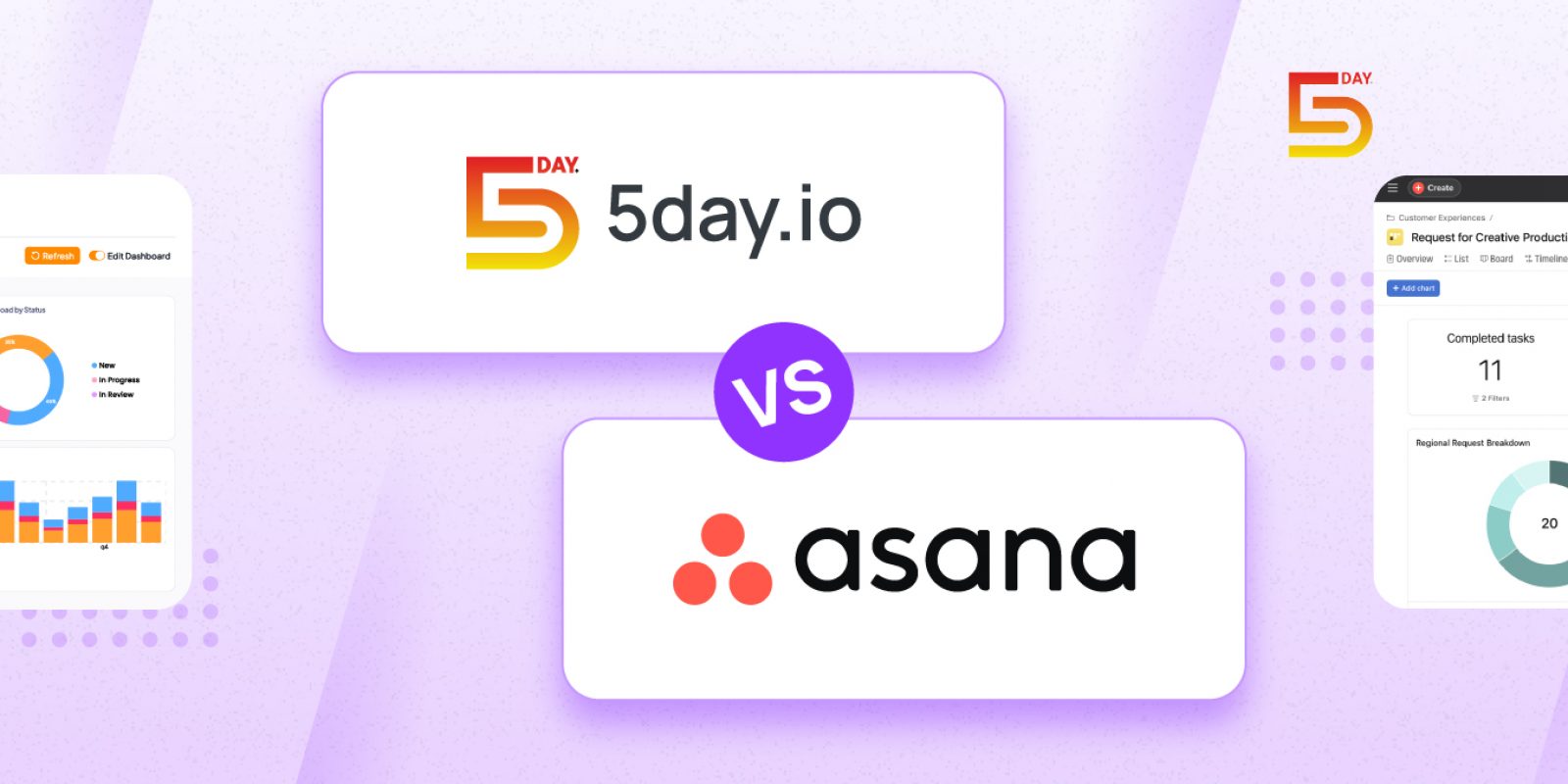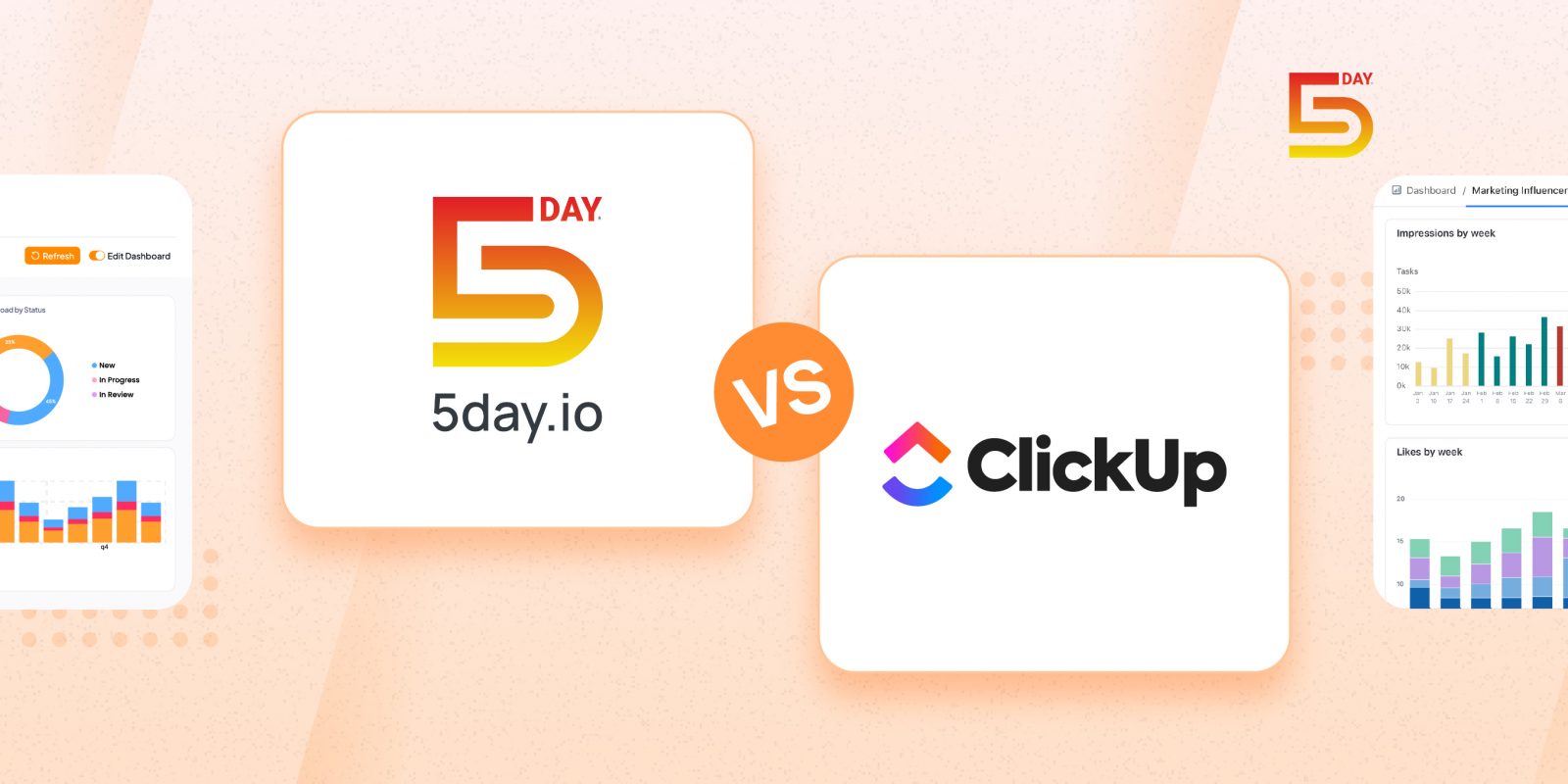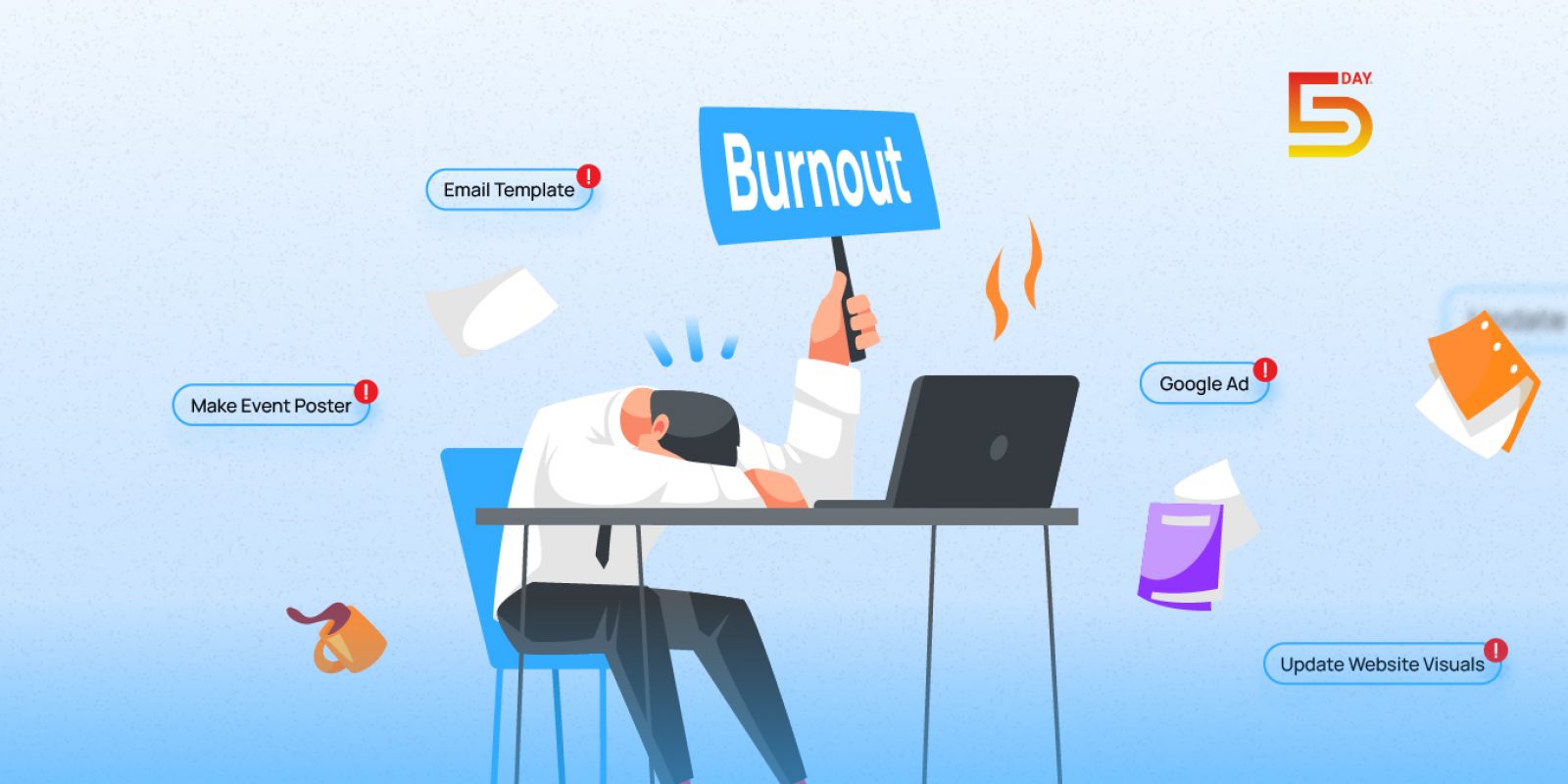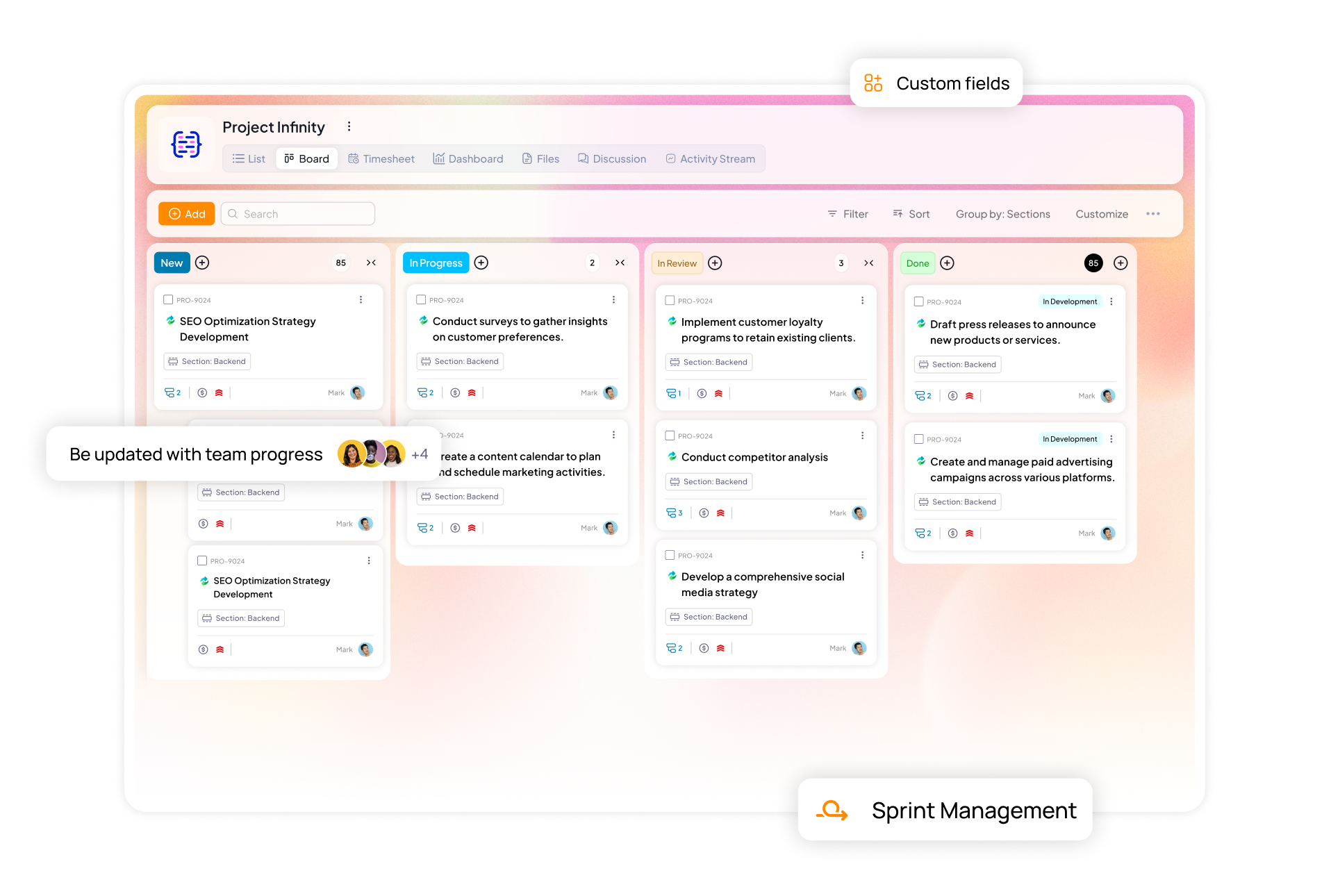A mid-sized SaaS team launched a high-stakes campaign last quarter. Big goals and tight timelines with too much faith in “figuring it out as we go.” They missed targets by 30%.
They’re not alone. According to Gartner, 87% of marketers reported campaign performance issues, and nearly half had to terminate their campaigns mid-way due to execution breakdowns.
The problem is that most plans ignore realities, such as team capacity, timelines, budget constraints, or execution flow.
In this article, you’ll learn how to create a marketing campaign plan , that goes beyond big ideas yet grounded in realistic planning. We’ll cover why realistic campaigns succeed and where most teams go wrong. And, most importantly, the exact marketing campaign steps to get it right.
What is a marketing campaign?
A marketing campaign is a strategic narrative your brand tells over time. It helps align your message and your team’s effort around a single, measurable objective. And when done right, it becomes the difference between scattered promotion and focused initiative.
What sets a campaign apart from day-to-day marketing is intentionality. You’re not just posting, but directing every move. Every asset, email, newsletter, or ad has a purpose and a place in the bigger picture.
Common types of marketing campaigns (and when to use them)
Here are some different types of campaigns and what to consider when choosing yours:
1. Brand awareness campaigns
Designed to make people aware that you exist. These campaigns live on top-of-funnel channels like social media and PR. Think storytelling over selling when working on a brand awareness campaign.
2. Lead generation campaigns
Designed to capture qualified contacts via content upgrades or gated content (like webinars or playbooks). Best when paired with a nurture marketing campaign plan.
Pro tip: Focus on quality, not volume. More leads aren’t better if they never convert.
3. Product launch campaigns
Time-bound, multi-channel campaigns that introduce a new feature or product. Typically includes pre-launch buzz and post-launch education.
4. Customer retention campaigns
Focused on upsell or loyalty. These are often lower-cost and higher-ROI, but frequently underutilized. These can be newsletters or loyalty points.
5. Re-engagement campaigns
Target inactive leads or customers with personalized nudges such as win-back emails or special offers.
6. Conversion-focused campaigns
These zero in on driving a specific action, usually purchases or signups, and often involve retargeting or urgency-led messaging.
A well-defined campaign type keeps your focus sharp. But where most teams go wrong is when they try to run a brand, lead generation, conversion, and product launch campaign in one calendar slot. That too, with the same small team.
That’s how marketing campaigns go off track. The reason isn’t that your idea was poor. More often than not, it’s that the execution plan wasn’t realistic for the resources available.
And if your campaign plan doesn’t account for that? You’re setting your team up for burnout.
Benefits of a well-planned marketing campaign
It’s easy to get caught up chasing creative highs, but the teams that win consistently are the ones who plan with precision. They scope the project based on bandwidth. They execute tasks on time and build creatives with intention.
There is a stark difference between the outcomes of unrealistic and realistic campaigns. Here’s a snapshot of results to understand what makes realistic marketing campaigns more beneficial.
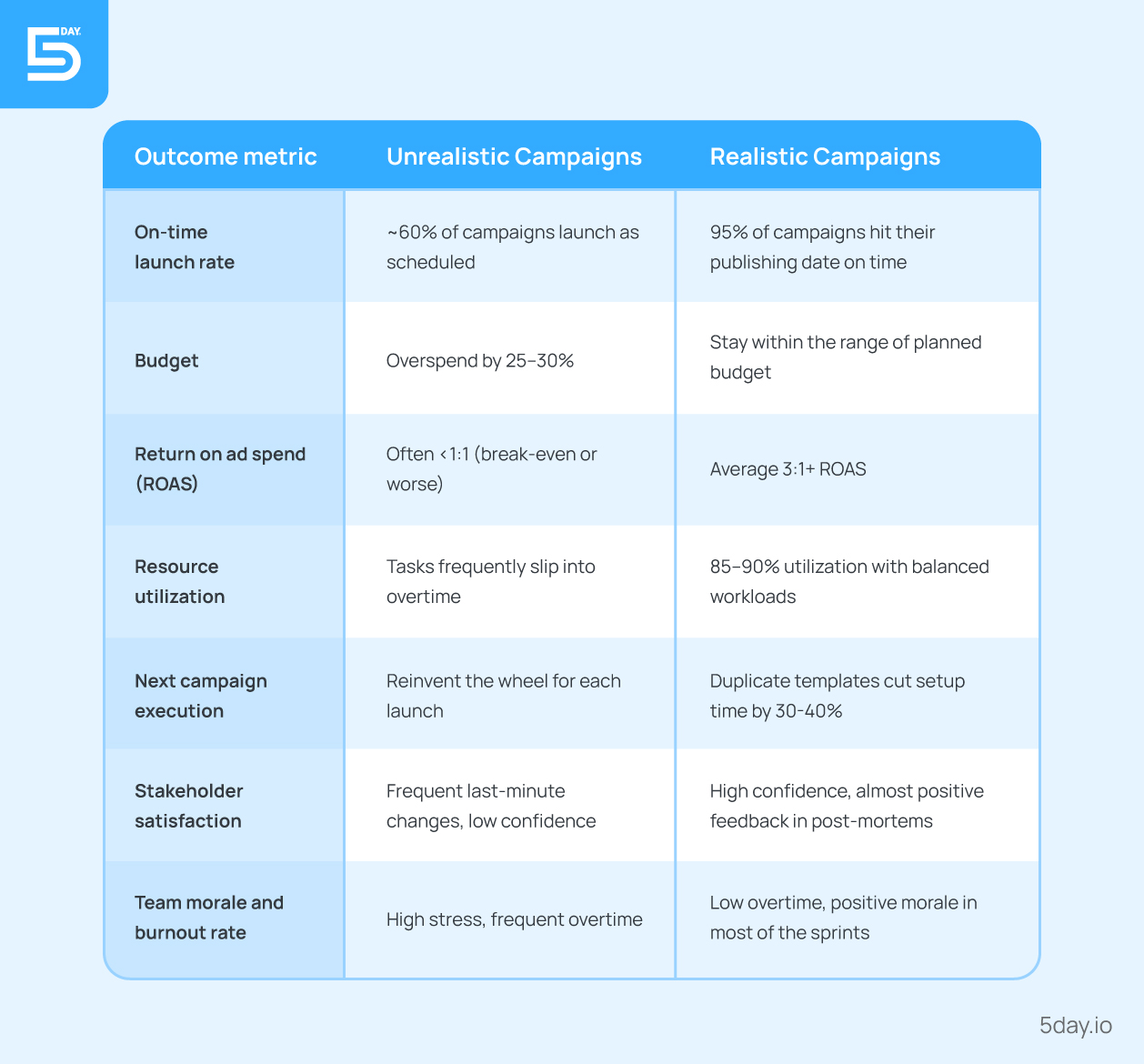
Learning about realistic and unrealistic plans is just a start. Now, let’s find out what happens when you implement an effective marketing campaign strategy focused on clarity:
1. Decisions get easier
When your campaign is built around a clear objective, every decision, from what to prioritize to what to postpone, becomes easier. You stop reacting and start steering. Realistic campaigns bring clarity, reducing friction across content and approvals.
2. Teams stop operating in silos
Campaigns often fail because of the fragmented execution. Designers didn’t know the messaging. Writers didn’t see the timeline. A well-planned campaign acts as a shared roadmap across departments.
Realistic campaigns are easy to divide into work items with project dependencies and deadlines, so no one’s flying blind.
3. Feedback becomes actionable
When your marketing campaign goals are realistic and measurable, feedback becomes insight. Instead of asking “why didn’t this work?” you can ask:
- Did we launch on time?
- Which was our highest-performing channel?
- Was the budget enough for all channels?
- Did we plan enough lead time for testing?
Realistic campaigns create a loop of learning that improves every future launch.
4. You reduce scope creep (and stress)
Unrealistic campaigns often balloon mid-way. Stakeholders add “just one more thing,” and deadlines shift, plus morale takes a hit.
Marketing campaign planning with realistic goals and timelines keeps expectations aligned and teams sane. Fewer surprises = better work.
5. Results are easier to replicate
When a campaign succeeds, you want to know why. Was it the timing? The content format?
You can’t answer that without a structured plan to benchmark against. Realistic campaigns help you isolate what worked, so you can do it again, better.
Marketing campaign planning guide: Steps to create a realistic marketing campaign
If you’re wondering how to create a marketing campaign, here are the steps to a successful marketing campaign that matches your ambition and bandwidth.
Step 1: Define a business-backed goal
Before you open a content calendar or sketch an ad, get clear on what the business really needs. For example:
“Drive awareness” is vague.
“Increase demo bookings by 25% to support Q3 revenue goals” is actionable.
Here’s what you need to do:
- Tie campaign objectives to actual business results
- Use recent performance benchmarks, and not wishful thinking
- Choose one primary KPI to measure success
Pro tip: Anchor your goal to a single metric, like leads or CTR (click-through rate), to avoid diffused efforts.
Step 2: Know who you’re talking to (define your audience)
Too many campaign managers assume they know the customer. In reality, they don’t. That’s why it’s important to match campaign length and touchpoints to how your audience buys.
Learn about different aspects of buyers and their journey:
- Pain points, language, preferences, and buying triggers
- What channels do they trust (like, Instagram or TikTok)
- Where do they drop off in your current funnel
Use tools like Google Analytics or CRM data to segment your audience meaningfully.
Step 3: Map your available resources
This is where most teams go off track. So, it’s crucial to build your marketing campaign process based on realistic resource availability. You need to know:
- Who’s available to work for the campaign?
- How many hours can you allocate?
- What content do you already have (that you can repurpose)?
Estimate realistic task durations (add a 25% buffer). List each member’s bandwidth, availability, key holidays, and concurrent projects.
5day.io project management is a great tool to break down tasks visually before locking in campaign timelines.
Step 4: Pick the channels you can execute well
A focused campaign on 2-3 well-managed channels beats a half-baked presence on eight.
Ask the following questions to get clarity:
- Which platforms have delivered results before?
- What content format do we already have the capacity to produce?
- Where is our audience most engaged?
For example, the best-suited channels that work well together are:
- LinkedIn + email + webinars for B2B lead generation
- Instagram reels + influencer stories + product landing page for B2C launches
Resist the trap of being everywhere, and focus on quality instead of quantity, always.
Step 5: Build a workback plan with deadlines
Realistic marketing lives in the timeline, not the brainstorm doc. A clear timeline turns vision into reality.
Work backwards from your go-live date:
- Break down each project deliverable (ads, copy, landing page, visuals)
- Assign owners and deadlines so everyone knows their part
- Identify project dependencies (for instance, design needed before ad setup)
5day.io offers features that apply a work breakdown structure (WBS). This allows you to break down tasks into structured work items with subtasks, due dates, comments, and reminders.
Step 6: Budget like it’s your own money
Don’t just throw money behind posts mid-way. Budget intentionally and upfront.
You can split the budget across:
- Media spend (ads, sponsorships)
- Content creation (video, graphics, freelancers)
- Tools (automation, analytics)
- Team effort (internal hours count too)
Use performance data from past campaigns to shape what to spend and where. For example, if YouTube drove CPLs (Cost per lead) 50% cheaper than Facebook last quarter, double down there.
Pro tip: Use a 70/20/10 rule, allocating 70% on proven channels, 20% on promising tactics, and 10% on experiments. Always keep aside 10% for unexpected pivots.
Step 7: Launch, learn, and adjust
Campaigns always tell their story with data. You need to track performance in real time and build in room to pivot. So, track the following metrics:
| Stage | Leading indicators | Lagging indicators |
| Awareness | Impressions, reach | Brand recall surveys |
| Engagement | Click-through rate (CTR) | Time on page, shares |
| Conversion | Form submissions | Sales, demo sign-ups |
| Retention | Email reopens, repeat visits | Churn rate, upsells |
Use project management analytics and time-tracking dashboards to view performance by task or team.
Step 8: Review
Wrap every campaign with a 30-minute retrospective:
- Was the campaign a success?
- What results did we not expect?
- Did we work as per the plan?
- What changes will we make the next time?
Document all the learnings. Turn them into reusable templates. That’s how to plan a marketing campaign without reinventing the wheel and build repeatable success. With 5day.io project management software, you can duplicate successful projects and create reusable campaign templates.
Common mistakes to avoid when following the steps to create a marketing campaign
Even the most creative marketing campaigns can fall flat if they’re built on shaky foundations. Marketing campaign challenges rarely stem from lack of skill or effort. More often, they are the result of planning gaps that only show up once the campaign is in motion.
By avoiding common marketing campaign mistakes, teams can make better use of their resources without burning out or starting all over again. Let’s find out how small shift in your approach can help you stay ahead of these mistakes.
1. Setting expectations right
When setting campaign goals, it’s natural to aim high, especially when there’s excitement around a new campaign launch or initiative. But goals grounded in data and past performance build more trust and deliver consistent wins. Plus, it’s easier to scale what works when everyone’s clear on where you’re going, and why. For example, a team expects a 6% conversion rate from cold traffic when historical campaigns averaged 1.8%.
So, it’s better to set performance targets based on actual data. Document your assumptions (like projected CTR or conversion rate) and share them transparently with stakeholders.
2. Underestimating the full campaign budget
Many teams plan media spend but underestimate the production costs or time. This oversight leaves campaigns under-resourced and unable to scale. Hidden costs to account for when planning a marketing campaign:
- Creative production (copy, video, design)
- Ad platform learning periods (Google Ads, Meta Ads)
- Software subscriptions
- Freelancers or consultants
- Team bandwidth
Fix it by budgeting for the entire lifecycle, not just ads. Add a 15–25% buffer for optimization or last-minute pivots. And, when you use tools like 5day.io project management software, tracking how much time goes into billable vs non-billable work helps you optimize budget and team energy. It becomes easier to reduce time spent on administration work and keep more focus on the work that drive results.
3. Poor cross-channel alignment
If your ad says one thing, and your email says another, you’re breaking the trust loop.
Disjointed messaging confuses customers and dilutes brand recall. So, it’s better to create a unified campaign brief that includes:
- Core message and variations
- Approved visuals and CTA formats
- Timing sequences for each channel
Pro tip: Use 5day.io’s project templates to assign messaging consistency checkpoints across teams.
4. Overcomplicating the structure
Marketers often try to do too much at once. They go for a new offer, a new channel, a new creative, and a new audience. As a consequence, it becomes impossible to pinpoint what worked (or didn’t).
Instead, launch with a lean version. Test one or two variables at a time, and scale only once you see traction. Simplicity is scalable and complexity is costly, so start slow to build upon it.
5. Failing to assign a single campaign owner
If ownership is split, decisions get delayed, and timelines slip.
So, it’s better to appoint a clear campaign lead with final say on deliverables and approvals. Define each team member’s role using a RACI (responsible, accountable, consulted, and informed) matrix or visual task structure to eliminate confusion.
6. Launching without testing
Running a campaign without validating your creatives or CTAs is like flying blind.
That’s why it’s important to use testing tools to get targeted results. A/B test subject lines, landing pages, and ad formats with smaller budgets. Test early and often, even if you’re short on time. It’s faster to test than to clean up after a flop.
Pro tip: Use UTM (Urchin Tracking Module) links and set tracking dashboards before launch to avoid post-hoc guesswork.
Tools and templates for campaign planning
Great ideas fizzle without having the right tools to scope, assign, track, and optimize them. When teams lack structure, even simple campaigns turn into exhausting marathons. That’s why having the right setup, and not a bloated stack, makes or breaks execution.
Here’s how to equip your team with the right software for marketing campaign planning and templates that bring clarity and control to every stage:
Project management tools
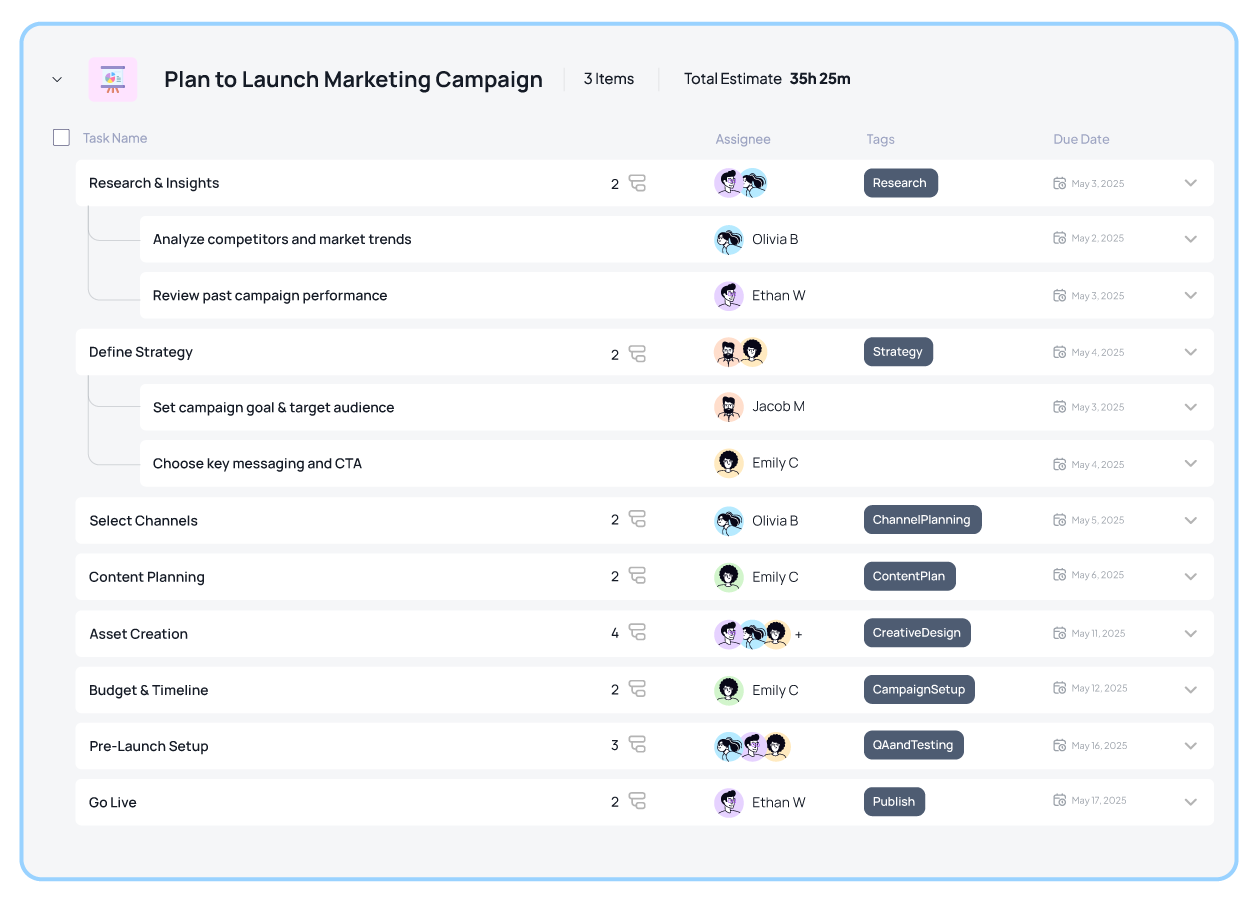
Realistic campaigns are built task by task. Without a centralized system, ownership gets confusing, and priorities lose focus.
Why 5day.io is built for marketing campaigns:
1. Visual planning with multiple views
See the entire campaign unfold across List and Kanban board views, perfect for aligning strategy and execution in one place.
2. Custom work item types
Tailor your workflow for blog posts, social posts, video shoots, paid ads, or webinars, each with its own stages and owners.
3. Subitem structure and task linking
Break down large deliverables into manageable chunks and link dependencies so the launch doesn’t stall because a creative was delayed.
4. Multiple assignees + time estimation tracking
Assign cross-functional tasks to designers, writers, and reviewers. Compare estimated time with logged time to uncover gaps in planning and better allocate resources for future marketing campaign management.
5. Templatized repeatable campaigns
Whether it’s a monthly lead generation or a quarterly product launch, create and reuse templates to launch campaigns faster with consistency.
Analytics & ROI tracking
Without clear data, campaigns rely on gut instinct, and that rarely scales. Here are some key tools every marketing team should use:
- Google Analytics: For website behavior, campaign tracking, and custom event goals tied to campaign conversions
- UTM Builders + URL Shorteners: Clean attribution from clicks to conversion (especially for organic and paid social ads)
- io’s built-in analytics: Track actual and planned effort, time spent per phase, and project progress for post-mortems and future forecasting
Pro tip: Use 5day.io to create a campaign dashboard that visualizes time logged and task progress in real-time.
Content & asset management
Marketing campaigns generate hundreds of assets. Without control, you get versioning chaos and missed approvals.
What to use to avoid asset overload:
- Canva – Fast visual content production with prebuilt brand kits
- Notion or Google Drive – Central hub for reference docs and drafts
- io – Attach assets directly to work items, track comments, and log approval dates
Campaigns move faster when feedback and files are all in the same place, rather than being buried in email threads.
Communication & approval workflows
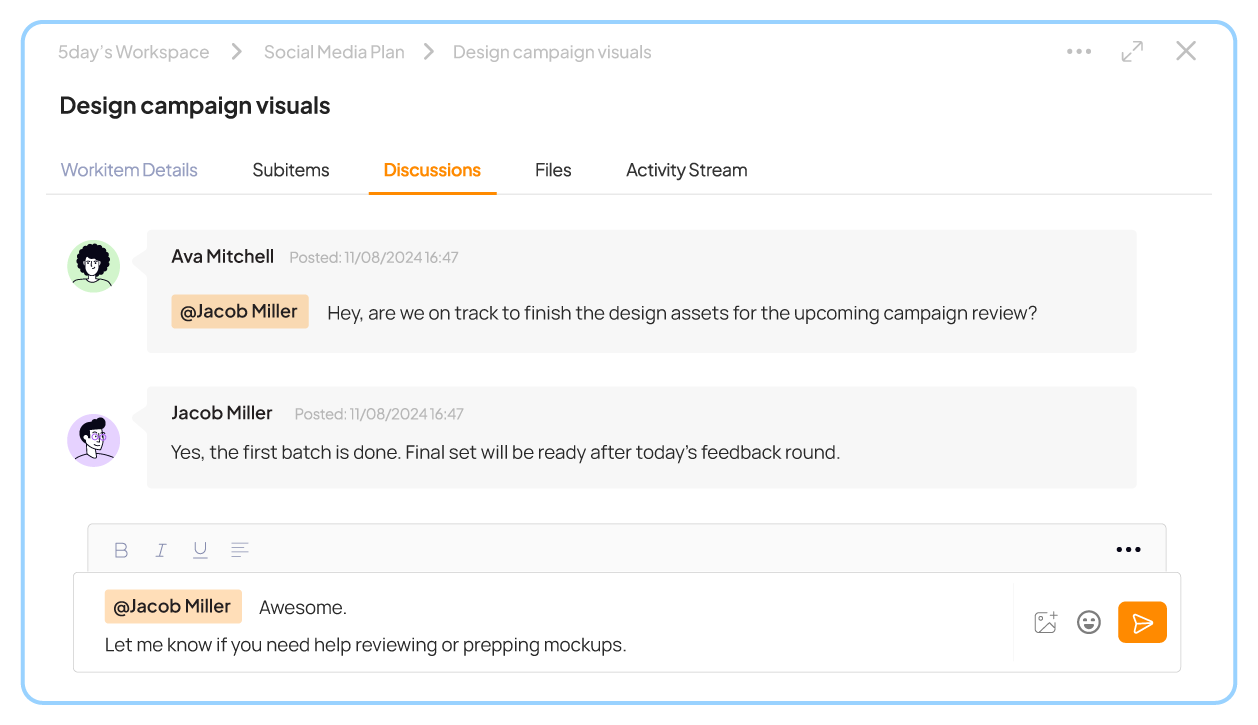
Delays rarely stem from doing the work. Instead, they come from waiting for feedback.
How to streamline communication and approval workflows:
- Use 5day.io’s approval tagging and comment threads to keep revisions clear
- Set reminders and due dates for internal sign-offs
- Automate notifications when dependencies are cleared so teammates can jump in instantly
Pro tip: Enable recurring tasks in 5day.io for weekly reviews or ad rotations.
Budget & resource planning
Campaigns often fail when budgets are built around hope. Use real data to plan the project realistically:
- Allocate hours to each task in 5day.io and track actuals to surface overruns
- Connect time logs to cost per campaign (internal + external resources)
- Export budget reports to analyze ROI per channel or asset type
Templates that save time and ensure consistency
Use templates that enforce best practices and reduce human error. This is one of the easiest ways to save time on both creation and checking for mistakes.
Smart templates to keep in your toolkit:
| Template Type | Purpose |
| Campaign brief | Align stakeholders on the goal, audience, messaging, and timeline |
| Timeline builder | Map tasks and dependencies from planning to launch |
| Budget tracker | Forecast and monitor spend vs. performance |
| KPI dashboard | Track engagement and ROI in real time |
| Pre-launch checklist | Catch red flags before campaigns go live |
Try 5day.io for managing your next (realistic) marketing campaign
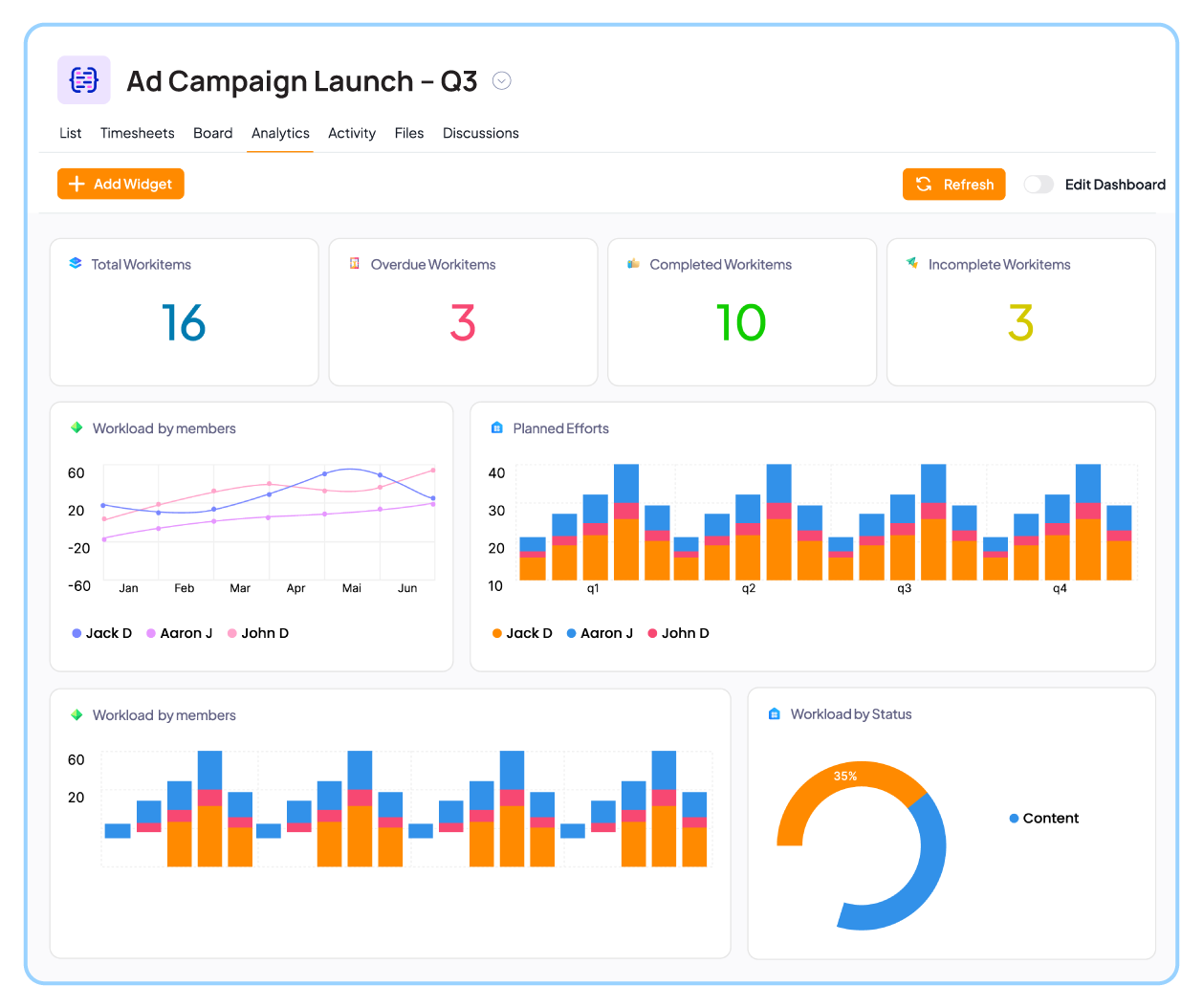
When you plan campaigns based on actual capacity and data-backed expectations, you build something far more valuable than a viral hit. And it’s the repeatable success.
Realistic marketing doesn’t mean playing it safe. It means:
- Making data-informed decisions, not assumptions
- Respecting your team’s actual bandwidth and timelines
- Optimizing based on insight and reducing unnecessary urgency
- Delivering value consistently so trust grows with every campaign
Realistic marketing is smart marketing because it generates predictable and consistent pipeline volume. It makes teams feel confident, and stakeholders stay bought-in with reliable business data. And how you manage it makes all the difference.
That’s where the 5day.io project management software comes in. It helps you:
- Visualize your campaign from kickoff to launch, so your team always knows what’s happening without digging through emails or spreadsheets
- Break down strategy into actionable, assignable work items to assign tasks clearly and keep execution aligned with your campaign goals
- Track timelines, budgets, approvals, and performance in one place to stay on top of your campaign’s pace and sign-offs
- Reuse campaign templates to scale what works and keep your campaigns consistent and compliant
- Give your team structure without adding complexity
Now you know how to create a marketing campaign plan, it’s time to turn it into a reality.
If you’re tired of campaigns that seem great in the kickoff meeting but spiral during execution, it’s time to try a better way. Start your free 3-month plan at 5day.io today.



